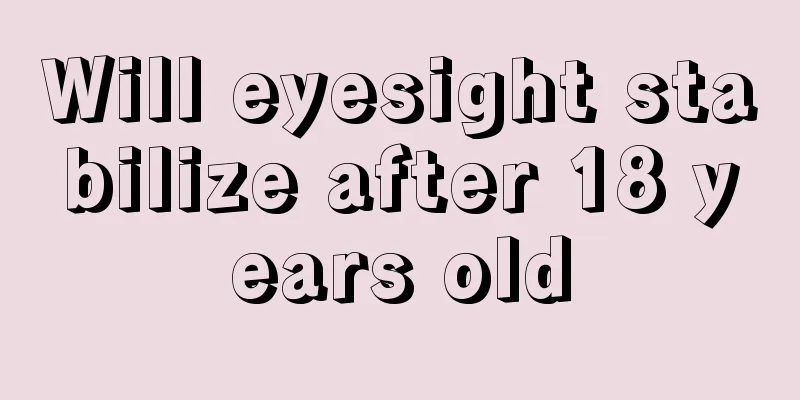Will eyesight stabilize after 18 years old

|
Vision is a very important visual health condition of the human body. Then normal people should have stable vision. However, some people may suffer from decreased vision due to bad living habits or other problems. Improving vision requires daily eye habits, and different changes will occur at a certain age. Will vision stabilize after 18? Generally speaking, for people aged eighteen, the development of various organs of the human body including the eyeballs has been finalized and stabilized, so the degree of myopia is not easy to change. However, a bad eye environment and bad eye habits will cause eye fatigue and also cause vision loss. It is not limited by age. It can only be said that the older you are, the less likely it is to get worse. In reality, there are many cases of people over the age of 20 whose myopia worsens due to excessive use of the eyes, especially excessive use of the Internet. There are even many people who did not have myopia before the age of 18, but developed myopia due to excessive use of the Internet after the age of 18. It is recommended to use your eyes correctly and not overuse them. Vision Standards Many people think that as long as the vision is above 1.0, it is normal. In fact, a visual acuity of 1.0 only means that a person's partial vision is normal. Strictly speaking, the standard for normal vision also includes the following: 1. Central vision: This is the vision that people usually determine by looking at the eye chart, including distance vision (looking at the eye chart at 5 meters away) and near vision (looking at the eye chart at 30 centimeters). Hyperopia is characterized by better distance vision than near vision; myopia is the opposite. People with astigmatism have poor distance and near vision. Only when the distance and near vision reaches 0.9 or above can it be said that the central vision is normal. 2. Peripheral vision: When the eyes are fixed on a certain target, the range that can be seen by the non-fixation area is large or small. This is called peripheral vision, which is also often called "peripheral vision". Generally speaking, a normal person's peripheral vision range is quite large, reaching 90 degrees on both sides, 60 degrees above, and 75 degrees below. Patients with myopia and night blindness have relatively poor peripheral vision, and some fundus diseases can also cause loss of peripheral vision. 3. Stereoscopic vision: Stereoscopic vision is the highest level of vision. That is, based on the normal central vision of both eyes, through the coordination of the two hemispheres of the brain, one can feel the distance relationship between objects in space. Some people have normal central vision but abnormal stereoscopic vision, which is medically called stereo blindness. Although we usually only check the central vision, in medicine, vision is considered normal only when the central vision, peripheral vision and stereoscopic vision all meet physiological requirements. Abnormal vision Shortsighted Seeing close objects clearly and distant objects blurry is professionally defined as "distant objects are focused in front of the retina after refraction by the eyeball, rather than forming a clear image on the retina." Myopia is the most common eye disease among Chinese children, and the rate of high myopia in mainland China is much higher than that among children in other countries and regions. Many eye diseases derived from high myopia are threatening the vision and eye health of many children. Hyperopia Nearby objects are refracted by the eye and focused on the retina, forming a blurred image on the retina. Therefore, patients with hyperopia cannot see clearly both near and far. Myopia is rare among infants and young children, but more than 90% of preschool children are hyperopic, most of which is physiological and a manifestation of normal eye development. 20% to 25% of hyperopia is pathological, which is the main cause of low vision and eye maldevelopment in children. amblyopia Amblyopia is a disease that seriously affects visual function. It refers to those people whose near and far vision is less than 0.8 and cannot be straightened without obvious organic lesions in the eye. According to statistics, there are more than 15 million people suffering from amblyopia, which has become a social problem that requires urgent attention. |
<<: Ear discharge becomes sticky and smelly
>>: What to do if blisters on tongue hurt?
Recommend
What are the methods to remove dark circles?
Many people like to stay up late, and for work re...
What are the effects and contraindications of Guilinggao
Guilinggao can play a very good role in reducing ...
Early symptoms of liver cancer
Liver cancer is a malignant tumor with various ea...
What's wrong with the tightness in the left chest
Most people do not pay attention to chest problem...
I felt cold and had a headache after coming back from the gastroscopy
In life, there are many patients with stomach pro...
How to treat pneumoconiosis? Prevention is crucial
Pneumoconiosis is an occupational disease and a s...
What delicious food is there in Zhangjiajie
Zhangjiajie is a very beautiful scenic spot in th...
Where is the pain in liver cancer?
Patients with liver cancer may experience pain. T...
What are some dietary tips for Bartholin’s gland abscess?
Bartholin's gland abscess is a disease that o...
What diseases does the health certificate mainly check for
People working in some special industries, such a...
My stomach and waist are cold after exercise
Generally speaking, we all know that exercise can...
What does donkey meat conflict with
Try not to eat donkey meat with chestnuts, grass ...
How to quickly remove ice from the refrigerator
If the freezer is frozen, you can increase the fr...
What is the treatment for elbow pain
Elbow pain is an experience that many sports enth...
How to nourish your body in winter
We need to supplement some nutrition in every sea...









